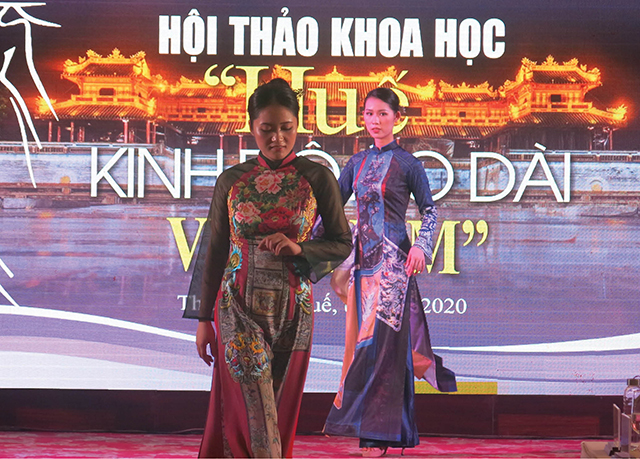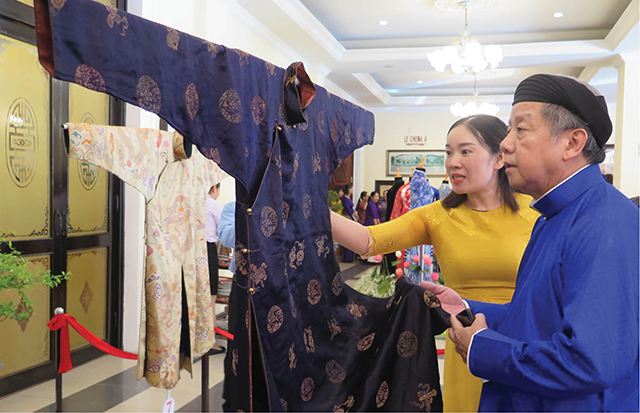
Introducing a collection of ao dai by Viet Bao, a designer, inspired by Hue’s imperial architecture
Hue - the birth place of the Vietnamese ao dai
In 1744, after being crowned King of Phu Xuan, Lord Nguyen Phuc Khoat issued a number of policies, including the reform of the royal court attire. Since then, the ao dai in Hue had been highly regarded and had become the main costume of people in Dang Trong (the Inner Realm).
If Lord Nguyen Phuc Khoat publicly established the ao dai, Emperor Minh Mang was credited with turning the ao dai into a popular costume for use from the North to the South, of which Hue held its position as the capital of ao dai.
According to Dr. Phan Thanh Hai, Director of the Department of Culture and Sports, costume reformations under the reigns of Lord Nguyen Phuc Khoat and Emperor Minh Mang not only were apparent in form, but also reflected the unified and autonomous thought about the culture of the flourishing dynasty. These two historical events were also very important prerequisites for ao dai to be born and widely spread from North to South. Ao dai became the dress of all walks of life, from kings, nobles, mandarins to civilians - men and women, and officially became the national dress.

Chairman of the Provincial People's Committee Phan Ngoc Tho visiting the exhibition displaying traditional ao dai within the framework of the conference
From the cradle in Hue, Vietnamese ao dai has become a symbol of the cultural identity of Vietnamese costumes, both elegant and unique. For Hue, ao dai also carries a golden past, a very unique style of the land of the ancient capital.
Nguyen Xuan Hoa, a researcher, said that in addition to the common characteristics of Vietnamese ao dai, Hue ao dai also has its own characteristics: “The five-body ao dai or the five-body dress, symbolizing the beautiful philosophy of humans: the four bodice of the front flap, the back flap symbolizes the "four parents", the inner body represents the child ... ".
In the other regions of the country, ao dai is usually considered formal attire. Particularly for Hue, ao dai is considered both as a formal attire and a casual outfit. In the past, the ao dai was associated with the activities of Hue people. Depending on the wearer and context, there were different adjustments made to ao dai. In the palace, the king wore ao dai when reading and eating meals ...; concubines also wore ao dai to sleep. In the folk life, teachers and students wore ao dai when teaching and studying. In households, adults wore ao dai when receiving guests, going to the market, selling goods, rowing boats on the river ...
Bringing Ao Dai back to its original position
Experiencing many ups and downs of history, the ao dai has always been considered an indispensable traditional costume of every Hue person from the past to the present. This is also the reason why Thua Thien Hue needs to invest in research to restore the position and trademark of "Ao Dai capital" of Vietnam, especially in the context that the province is trying to implement Resolution 54. -NQ / TW of the Politburo.
Nguyen Xuan Hoa, a researcher, asserted that it is necessary to affirm Hue ao dai as a unique cultural value in Hue cultural heritage, in order to justify the brand name of Hue ao dai as a unique intellectual property of the ancient capital. In addition to campaigning for women to wear ao dai in daily activities, Thua Thien Hue needs to organize more activities to promote and honor the beauty of Hue ao dai, such as organizing Hue ao dai Festival on a large scale, attracting people to participate; encouraging the construction of Hue ao dai shows. At the same time, the province needs to promote the establishment of the Hue Ao Dai Production and Business Association, to promote investors to develop Hue ao dai business and production...
Nguyen Duc Binh, (painter) Chairman of the “Vietnamese Village Communal House” Club proposed that with the position of the hometown of ao dai, Thua Thien Hue needs to take measures to revive the production of five-body ao dai and to form teams of skilled workers so that their names and products are closely associated with the Hue brand name as the Vietnamese ao dai capital; to organize modern ao dai designing competitions; to mobilize officials, public servants and officers to wear ao dai in ritual spaces and traditional cultural spaces ...
Speaking at the conference, Chairman of the Provincial People's Committee Phan Ngoc Tho said that traditional ao dai is an integral part of Vietnam's cultural heritage; however, it has not been officially recognized as a cultural heritage. Therefore, this conference also creates a premise to build a dossier to recognize Hue traditional ao dai as a national intangible cultural heritage and request UNESCO to recognize ao dai as a representative intangible cultural heritage of humanity.
Chairman of the Provincial People's Committee emphasized: “To build Hue to become a capital city of ao dai, it is necessary to take practical actions to bring ao dai back to its inherent position in the hearts of the ancient capital of the people, such as: continuing to encourage officials, civil servants, students to wear ao dai more frequently; requesting Hue Monuments Conservation Center officials to wear traditional ao dai; offering free admission to monuments for people wearing ao dai; mobilizing small businesses and many other people to wear ao dai at Hue Ao Dai Festival which will take place during Hue Festival 2020.
The Chairman also affirmed that he will wear ao dai in the reception of ambassadors. In addition to organizing the Ao Dai Festival to honor the ancestors who had given birth to ao dai, Hue will build a space to display Vietnamese ao dai and Hue ao dai.
Story and photos: Minh Hien
